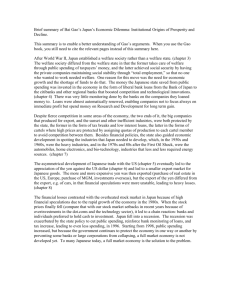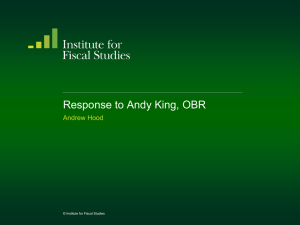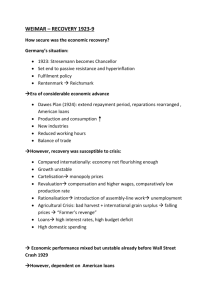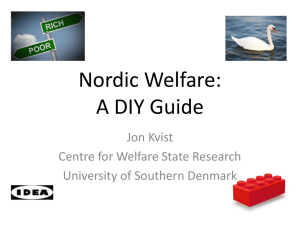The Swedish Model
advertisement
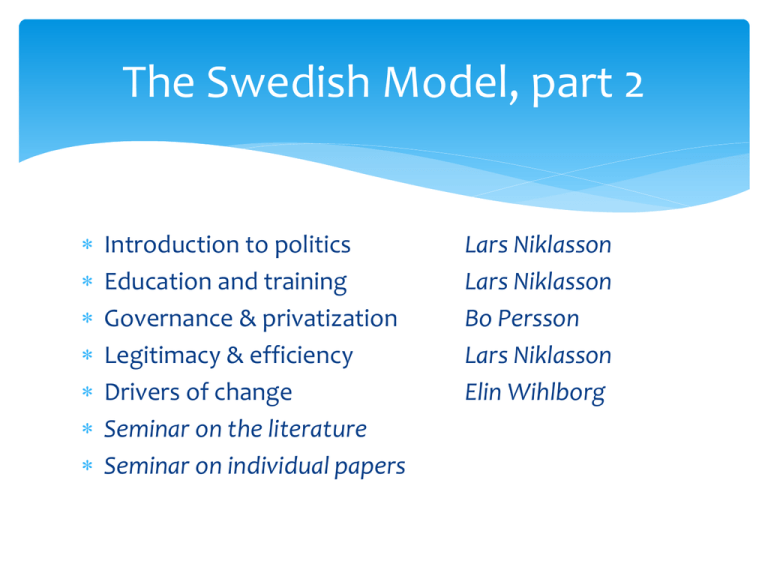
The Swedish Model, part 2 Introduction to politics Education and training Governance & privatization Legitimacy & efficiency Drivers of change Seminar on the literature Seminar on individual papers Lars Niklasson Lars Niklasson Bo Persson Lars Niklasson Elin Wihlborg 7. Introduction to the politics of the welfare state 1976-82-91-94: Challenges and decentralization 1995: Membership of the European Union Late 90s: Cutbacks to save the welfare state Too generous to work? 2006: Back to ”work for welfare” (Arbetslinjen) = Reforms to save the welfare state? Influence from 1997: The European Social Model Whereto? A Social Investment State? A new type of welfare state? (Morel, Palier & Palme, intro) 1. Social investments in skills and modern needs/risks (work/family life, change of careers etc.) = an Economist’s perspective on welfare: utility rather than social rights, ”productive social policy” = Collective responsibility Alva and Gunnar Myrdal: families and women (Wanted selective policies) 2. Keynes: the macro economy, more traditional/male 3. Neoliberals: rigidities, market distortions, gov’t failure Three paradigms (table 1.1) SIWS as a hybrid A new type of welfare state, continued Critique: Less support for passive unemployment with the focus on ”activation” Less support to stay outside the labor market Bad implementation of policies against exclusion in the Lisbon strategy An instrumental view on women and children (as labor force) Divergent views (Nordic vs Anglo-Liberal): Esping-Andersen on positive effects of social rights, aim for equality, combination of investment and protection Giddens on moral hazard and duties, beneficial inequalities, support as springboard, from passive to active measures Waves of transformation (Hemerijk 2012) 1. Keynesianism after WWII (the Depression) From charity to right, taming capitalism, class compromise, embedded liberalism (Bretton Woods) 2. Neoliberalism after the 70s (Stagflation) Monetarism (balanced budgets, low inflation, stable currency), flexibility, gov’t as problem, selective policies OECD Jobs Study 1994: high unemployment in Europe, EMU to limit politics, social pacts/not cutbacks 3. Social investment since 90s (the Third Way) OECD 1996, EU 1997, Esping-Andersen et al 2002. A balance. The welfare state can be positive for competitiveness. Structural (not cyclical) unemployment needs capacitating services Social investment (Jenson 2012) Beyond neoliberalism: critics on the left and right Investment (not spending) = future profits Responsibility mix: market, family, community, state Universal coverage Fostering prevention, rights and duties Governance through networks: communities (?) (Sweden: Learning accounts, citizen choice?) Neoliberalism failed: high spending & problems in Europe, experiments in Asia, revised ideas 1997 (World Bank) Ageing populations (Lindh 2012) Demographic transition: problem and opportunity Ageing population effect in 2030-40 National variety, National Transfer Accounts Transfers over the life cycle: independence, retirement Life expectancy, fertility rates: dependency rates Work longer, have more babies: welfare support Pensions: savings or pay-as-you-go Parental leave Consequences for jobs: more services, less goods Post-crisis policy (Diamond & Liddle 2012) More barriers to European social policy due to aftershocks of the crisis, especially public finance Direct effects: unemployment, austerity EU divergence Globalisation winners and losers Demography Migration The state remains big but changes its role (NPM) An opportunity for a European Social Model? Climate policy (Sommestad 2012) Social policies to support climate policy Market-based climate policies: emissions trading Income equality leads to better climate (?) Public ethos, economic instruments regressive Sectoral impact: less agriculture, energy-intensive industries, more transport Need for industrial policy, employment policy, dialogue, public investments (-- a role for markets, banks?) The new economics of sustainable development (Stern) Long-term investments in public goods: education etc. From Lisbon to Europe 2020 (Lundvall & Lorenz 2012) The Lisbon Strategy (2000): wide and with a goal: ”The most competitive region in the world” ”Europe 2020” (2010): narrower, with priorities Smart, sustainable, inclusive growth (+targets) Continuity with the focused Lisbon Strategy 2005-10 Still weak implementation (OMC), change of majority, SGP European Employment Strategy: quality jobs? Flexicurity? Less competitiveness with less cohesion? No understanding of the learning economy (or EMU) A transnational welfare state needed = European identity A new economic model (Morel, Palier & Palme, conclusion) A paradigm in search of a new economic model Modernising ideas Capacitating policies: education, family, employment Weak implementation: Increase in expenditure, not investments Protection and promotion: the Nordics (NL, UK) Activation = third way = ”too close to neoliberalism” The analysis: disincentives, lack of flexibility The solution: working poor. (Conservation?) Skills are needed. A new economic model, contd. With high skill jobs, more difficult to employ migrants New national accounts? Investments vs consumption Political triggers: competition for the female vote Against neoliberalism (– a new coalition of socialists and conservatives? mercantilism, competitiveness) Germany not a viable alternative (?) Gradual change may lead to paradigmatic change Morel, Palier & Palme 2012: Towards a social investment welfare state? Ideas, policies and challenges 1. What are the differences between Giddens and EspingAndersen on Social Investment policies? 2. What are the three waves reactions against? 3. What are the differences between investments and savings? 10. In what sense is demography an opportunity? 11. Is the crisis an opportunity for a European Social Model? 12. What is the link between social and climate policies? 13. What is missing in Europe 2020? 14. What kind of coalition(-s) would support a European Social Model based on the idea of social investments? 8. Case study: Education and training Two parts: Primary, secondary, tertiary education Skills development and training for adults Structures, actors, processes, achievements Challenges European comparisons (Morel, Palier & Palme 2012) Education policy Pre-school, primary school 1-9, secondary 10-12 National curricula, framework legislation and control Local and private implementation A strong focus on results since 2006: more uniform A debate on segregation, vocational programs Higher education Xx universities (PhD-granting) Yy colleges (limited PhD-granting) Several private, two independent Also some vocational tertiary education (YH) Student loans to study in Sweden and abroad Quasi-market since 1993: Formula funding, deregulation, quality control Fees for non-EES students (except exchange) What drives innovation in higher education? Competition and/or top-down inititives? Labor market policy: training Active labor market policy, ALMP = training programs A national policy: people need to move to the jobs Formerly regional and corporatist, now centralized Performance targets lead to creaming Exclusion: difficult to help clients with many needs Local collaboration or competition? Training programs by local and regional gov’ts too ”One door in”, joined-up government bottom-up: Infotek = guidance, Lärcentrum = co-location Consistent? Efficient? The policies overlap in adult education Are the systems integrated? Do they promote equality (of opportunity/outcomes)? Do they support individual development? Do they support economic growth? Next lecture on governance and privatization Good for the citizens? More integrated public services? More adaptable services? Not good at solving complex problems, or these problems are now more visible? Fighting exclusion Support for economic growth (better skills development? A strong business climate?) Accountability? OECD comparisons (Nikolai 2012) Compensatory policies: unemployment, old age Investment policies: ALMP, family, education Spending convergence over time Spending in cash or in kind (services) Expansion of old age insurance and family benefits ALMP: more activation, less spending Four clusters (low/high) Figure 4.3-4.6 Increased spending but less on education Convergence on Scandinavia or the UK? Employment policies (de la Porte & Jacobsson 2012) The European Employment Strategy, EES 1997 After EMU, to develop skills, part of the Lisbon Strategy Synergies of economic, labor market and social policies Targets the continental and Mediterranean countries Soft policy, OMC: increased employment due to EES? Policy frame: problem, goal, benchmarks, instruments Contradicts the economic policy frame (EMU) Flexi+curity, employability, a role for social partners EES has become a reference point, but little change Employment policies, contd The Nordic countries: big fit Less quality in activation, structural issues not reformed The English-speaking countries: fit UK: Domestically driven reforms, Ireland: ESF The Continental countries: misfit More activation, ”Modèle danois”, Hartz reforms The Mediterranean countries: misfit More flexibility, less security (opposite of social investment) The East European countries: low spending Activation and flexibility, weak social partners Work-family policies (Morgan 2012) Female employment, gender equality, child care Pioneers: France, Norway, Sweden Path-shifters: Germany, Netherlands, UK Slow-movers: Austria, Italy, Spain Political forces: new ideas? Barriers? Electoral strategies (Sweden and Norway) The representation of women in politics General conservatism in the slow-moving countries Active labor market policy (Bonoli 2012) Ambiguous concept. Four (six) types (table 7.1): Investment in human capital? (or incentives to work?) Pro-market orientation? (or temporary jobs?) Spending profiles in six countries (figure 7.1) General decline 1995-2005, except the UK Reduction of ”job creation”, increase of ”employment assistance”, decline of ”training” Spending levels: Nordic, Continental, UK From education (60s), via occupation (70s) to re-entry (90s). Laggards become leaders: Denmark, UK. More and better jobs? (Nelson & Stephens 2012) Investment policies are related to knowledge-intensive services and discretionary learning employment Problems: overeducation? Inhibiting business investment? Relevant adjustment of content? But: markets aren’t perfect, education is undersupplied (?), a need to recruit internationally Data: (1) 1972-99, (2) cross-sectional correlations USA at top and bottom Investments lead to employment and quality jobs The globalizing learning economy (Lundvall & Lorenz 2012) A need for organizational learning and networking Discretionary learning = more autonomy than in ”lean production” (But: standardized processes!) North vs south High skill jobs less exposed to foreign competition Flexicurity makes it easy for firms to upgrade and makes individuals less risk-averse Vocational training and informal learning Equality, openness and trust Learning by doing and by interaction with customers etc. Social investments on an international scale for migrants? Morel, Palier & Palme 2012: Towards a social investment welfare state? 4. What spending patterns can we see over time? 5. Which groups of countries have increased the policies of activation? 6. What are the political drivers and barriers for and against equal rights for women? 7. How did the laggards become leaders in ALMP? 8. How can social investments lead to better jobs? 9. What are the pros and cons of flexicurity? Niklasson 1996: ”Quasi-markets in higher education – A comparative analysis” 1. What is the difference between ”market by design” and ”market by interaction”? 2. In what sense did the regulation of the universities converge on a common model? 3. In what sense did Sweden and the UK move in opposite directions?


